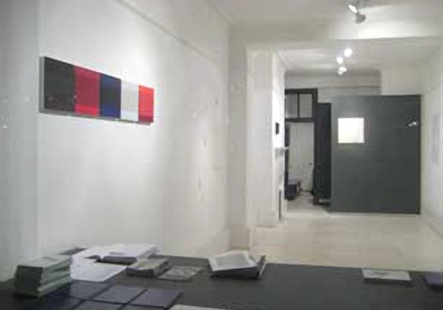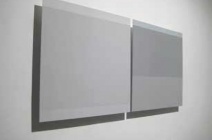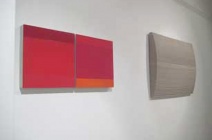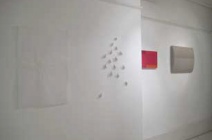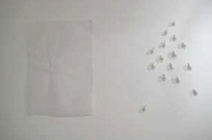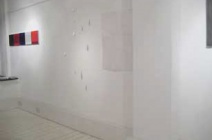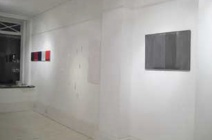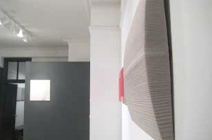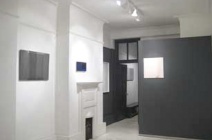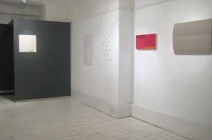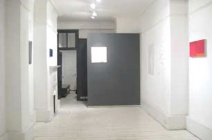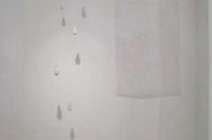Particular Beauty
Particular Beauty
Faith Vincent, Helen Cass, Sally Haworth
Pulverized particles of marble, aluminium, porcelain and pigment are reconstructed into new forms in this exhibition. The works displayed continue the modernist tradition where there is no illusion; they celebrate the surface in subtle and unique ways.
Aluminium powder, marble and porcelain dust give colour to Helen Cass's muted works. Stacks of ironed tablecloths and linen are recreated in her beautiful and silent folded canvases. The furrowed soil and ploughed land that she reproduces in the canvases now are rendered permanent by use of resin and dust.
As Richard Noyce suggests: "While at first glance her work may appear to be coolly abstract, derived from straightforward formulas of proportion and tone, the truth is somewhat different, linking to agrarian traditions and family history. Her working processes are … in a direct line from those that sustained very different patterns of work and the way of life in former generations of her family…What, at first glance, seems to be a simple repetition of ink marks or folds built up to create a surface turns out to be something far more complex. Her work offers a way into a consideration of how memory can operate in an individual life. It also offers something further - an understanding of the manner in which this art, and in turn all art, is made…
The process of making art becomes a ritual, no different in essence from those rituals of the past that required an equal degree of attention, whether in the home or in the fields. In all these there is a profound sense of their needing to be done, regardless of the other demands on the person fulfilling the task. Once the final work is done, be it a cupboard full of ironed household linen, a well-ploughed field, or a work of art, there will come a moment of completion, of another circle being closed. This is the continuing process in which rituals mark out the passage of life…"
Intense, flat fields of colour animate the surface of Sally Haworth's works. Each aspires to capture the essence of light and shade, movement and stasis. Rich hues fill these objects with a fresh energy that is both mysterious and exhilarating. Whether vibrant or delicate, pigment imbues the work with spirit.
Composition is achieved through the juxtaposition and layering of contrasting surfaces. Colour, texture, translucency, opacity and reflective qualities interact to create dynamics of exposure and concealment, harmony and discord. Content is released through manipulation of space, colour and light. Materials such as metal, fabric, paper, pigment, acrylic and oil unite.
The work is minimalist in its economy and formality, yet it is spacious and voluptuous, employing rich and sensuous materials. A dialogue between conflicting traits is encouraged through the works' physicality, substance and context. Simultaneously delicate and solid, they embrace the traditional and contemporary, Eastern and Western, organic and synthetic, the concrete and magical. These associations illuminate the productive potentiality and new dynamics created through resolution of the diverse and the disparate.
Derived from a multiplicity of sources they examine inherent polarities within established traditions. They challenge perceptual and conceptual tendencies in twentieth century abstraction and question the relationship between painting and sculpture, Tension creates its own dialectic. Whilst the works strive to trumpet strength, vitality and optimism, they reflect the search for a new direction and morality.
Marble dust coats Faith Vincent's white works. Many small fragments shaped like small pods or buds group together in Gathering. Their forms are hopeful, a beginning. Their constellations are playful, their movements charming. For the artist, white is the colour of fear, of nothingness. It is the combination of all colours, it is the ultimate. The 'crushed snow' of their final coating is made of marble dust from Carrara, Italy. It is a tough, icy and protecting. White on white, these brightly lit, mute droplets create potentially sinister shadows; dark shapes hint at the hanging's presence.
The marble dust drawings on tracing paper appear like an imprint, like a shadow taking form. The drawings make the paper buckle.
In the piece 'a feeling of weight' Vincent was working with the sensation of silently bearing something heavy, yet at the same time knowing that that this huge thing was barely discernable, like the sallies (soft pulls) of a bell ringer rendered useless, the weights hang by a thread.

